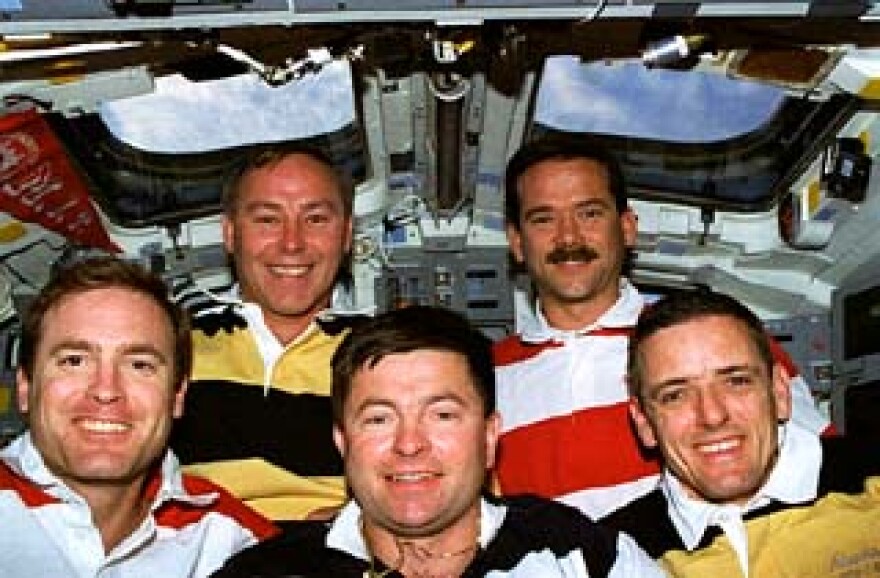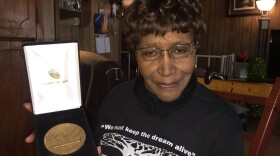Alabama Public Radio is observing forty years on the air in 2022. The APR news team is diving into our archives to bring you encore airings of the best of our coverage. So far this month, we’ve featured stories with a space theme. July was the month, back in 1969, when Apollo 11 landed on the moon. Not all of APR’s NASA related coverage has been upbeat. This archive story by Pat Duggins from last year involves a former astronaut and the death of two sisters in Tuscaloosa.
A five time Space Shuttle astronaut is now a convicted felon. James Halsell stood before a Tuscaloosa County judge and pleaded guilty to two counts of manslaughter in the 2016 traffic crash that killed two young girls. APR has been following the case from the beginning. It was a shock to observers of the space program and a long wait for justice for the victim’s family.
“For me and my family, we just tired," said Latrice Parler. She's the mother of Jayla Parler and Niomi James. “It’s been a long five years, and we need to rest."

Parler was in the same car and Jayla and Niomi when prosecutors say Halsell rammed his vehicle into theirs. One of the sisters died instantly. The other was pronounced dead at local hospital. Latrice Parler read from a prepared statement. In the hallway after the hearing, she talked about the message behind it.
“I want the world to know that my daughters were amazing, beautiful, smart, strong little girls that could have been anything in this world had they the opportunity to grow up. But that was taken from me and everyone else in this world. And, I miss them.”
Parler says either could even have been an astronaut, like the man who pleaded guilty in their deaths back in June of 2016. For twenty four hours, local media outlets apparently didn’t know what they had. The crash was reported in newspapers and on television news shows. But, it took time before reporters learned the prime suspect in this case had been to space five times.

“Over on the far right in the line here, is Lieutenant Colonel Jim Halsell,” said astronaut commander Ken Cameron during a Kennedy Space Center press conference in 1995. “He’s the pilot for this mission…experienced…flew on STS-65 (a Shuttle science mission in 1994.)
For observers of the U.S. Space Program, today's guilty plea stands in sharp contrast to James Halsell’s career as a veteran Space Shuttle commander at NASA.
“Thanks a lot,” said Halsell to Cameron. “My pleasure to be here, as Ken said, we’re happy with the weather today.”
This one of a number of times he took questions from reporters before a space mission. It was 1995, and Halsell was preparing to fly as co-pilot of Space Shuttle Atlantis to the Russian Space Station Mir. My last one-on-one interview with him was five years later. It was the year 2000, and I was getting miked up for a chat in an unusual location. Halsell and I were both insde the cockpit of Atlantis.

“It’s smaller in here than you’d think,” I commented back then.
“Yeah,” replied Halsell. “When we do press conferences in space, we all jam up in this corner right here, and put the camera in the far corner. And, since it’s a wide view lens, it looks a lot roomier than it is, as you can see from being here yourself.”
The spaceship isn’t in orbit. It’s sitting inside its maintenance hangar at Kennedy Space Center in Florida just before its final mission. Halsell is crouched in one spot of Atlantis cramped cockpit, and I’m sitting across from him. We’re each in white coveralls and caps, nicknamed bunny suits at NASA. I was one of a dozen space journalists invited in crawl inside Atlantis to interview Halsell. The star of the show wasn’t the astronaut, but rather the Shuttle’s dashboard
“The Shuttle design was frozen somewhat back in the 1970’s and 80’s, and we were kind of lived in that frozen situation, until now,” said Halsell.
Atlantis just got an expensive upgrade. The outdated mechanical buttons, dials, and gauges were all gone. In their place was what’s called a “glass cockpit.” It’s a collection of small computer screens that feature the same instruments.

“It is truly not possible, in my opinion, to fly the aircraft on ascent by looking out the window. You need to concentrate on the information featured here,” said Halsell, while pointing to the instrument panel. “This is where you going to become aware of any problems, and what corrective actions you need to take."
All of that didn’t change what happened involving Halsell sixteen years later.
All of that didn’t change what happened involving Halsell sixteen years later. Before sentencing, both the District Attorney and the defense brought up Halsell’s long career at NASA. DA Hays Webb says Halsell’s experience should have prevented from drinking wine and taking prescription sleeping pills before getting behind the wheel in 2016. The defense talked how Halsell handled one Space Shuttle during an emergency. For Latrice Parler, it was how Halsell’s described his public service with children that was too much to take.
“Especially when his defense stated that he had done so much with children, and he added my daughter’s name as if she was still here. He said just like Niomi, and Niomi isn’t here," said Parler. "And you’re telling me what he has done and what he could still be doing.”
Halsell’s two manslaughter counts carried a possible sentence of up to twenty years each. The two DUI assault charges could have added ten years each on top of that. In the end, the judge have the astronaut what in legal terms is called a twenty split four. That means he’ll spend four years behind bars.

























